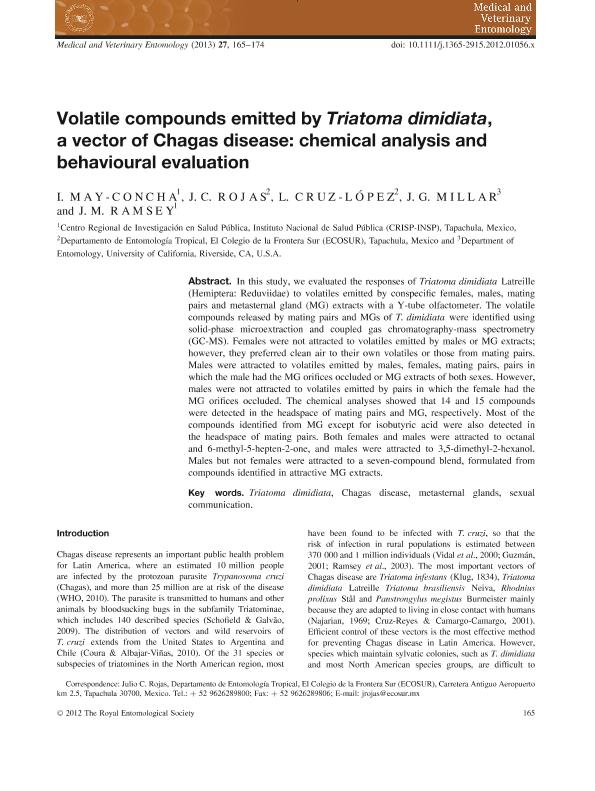Artículo
Volatile compounds emitted by Triatoma dimidiata, a vector of Chagas disease: Chemical analysis and behavioural evaluation
Fecha de publicación:
06/2013
Editorial:
Wiley Blackwell Publishing, Inc
Revista:
Medical and Veterinary Entomology
ISSN:
0269-283X
Idioma:
Inglés
Tipo de recurso:
Artículo publicado
Clasificación temática:
Resumen
In this study, we evaluated the responses of Triatoma dimidiata Latreille (Hemiptera: Reduviidae) to volatiles emitted by conspecific females, males, mating pairs and metasternal gland (MG) extracts with a Y-tube olfactometer. The volatile compounds released by mating pairs and MGs of T. dimidiata were identified using solid-phase microextraction and coupled gas chromatography-mass spectrometry (GC-MS). Females were not attracted to volatiles emitted by males or MG extracts; however, they preferred clean air to their own volatiles or those from mating pairs. Males were attracted to volatiles emitted by males, females, mating pairs, pairs in which the male had the MG orifices occluded or MG extracts of both sexes. However, males were not attracted to volatiles emitted by pairs in which the female had the MG orifices occluded. The chemical analyses showed that 14 and 15 compounds were detected in the headspace of mating pairs and MG, respectively. Most of the compounds identified from MG except for isobutyric acid were also detected in the headspace of mating pairs. Both females and males were attracted to octanal and 6-methyl-5-hepten-2-one, and males were attracted to 3,5-dimethyl-2-hexanol. Males but not females were attracted to a seven-compound blend, formulated from compounds identified in attractive MG extracts.
Palabras clave:
Chagas Disease
,
Metasternal Glands
,
Sexual Communication
,
Triatoma Dimidiata
Archivos asociados
Licencia
Identificadores
Colecciones
Articulos(CICYTTP)
Articulos de CENTRO DE INV.CIENT.Y TRANSFERENCIA TEC A LA PROD
Articulos de CENTRO DE INV.CIENT.Y TRANSFERENCIA TEC A LA PROD
Citación
May Concha, Irving Jesus; Rojas, J. C.; Cruz López, L.; Millar, J. G.; Ramsey, J. M.; Volatile compounds emitted by Triatoma dimidiata, a vector of Chagas disease: Chemical analysis and behavioural evaluation; Wiley Blackwell Publishing, Inc; Medical and Veterinary Entomology; 27; 2; 6-2013; 165-174
Compartir
Altmétricas




